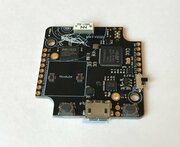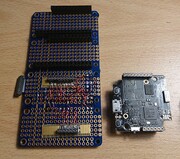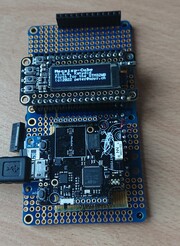Mecrisp-Cube for the Katydid Wearable BLE Sensor Board
Intro
If you want a small BLE board with a QSPI NOR flash memory, a BMA400 low-power accelerometer, an STBC08 LiPo battery charger, and connectors for a variety of sensor modules then this board could be the right board for you.
The Katydid Wearable BLE Sensor Board is designed by Tlera Corp.
The GPIOs are very carefully selected. JTAG SWD is on the pin header too!
Instant real-time programming with Forth.
Sources on GitHub
is designed by Tlera Corp.
The GPIOs are very carefully selected. JTAG SWD is on the pin header too!
Instant real-time programming with Forth.
Sources on GitHub (Katydid branch on Mecrisp-Cube)
(Katydid branch on Mecrisp-Cube)
Features
The standard Mecrisp-Cube features like RTOS, Filesystem, USB, etc.- 63 KiB RAM Forth dictionary
- 384 KiB Flash Forth dictionary
- 160 KiB Flash for C code
- Internal Flash drive 0:, 16 MiB NOR Flash (similar to MicroSdBlocks#STM32H743_Nucleo_QSPI_W25Q128)
- microSD drive 1: (needs external adapter)
- Digital and analog pins
- LED1 (blue), PE4
- Button, PH3
- Digital port pins: D0, D1, D10 to D15; module connector D2, D4, D5
- Analog port pins: A0, A1; module connector A2
- PWM: TIM1CH3 D0, TIM1CH2 D1
- Input capture TIM2CH2 A1
- Output compare TIM2CH1 D13, TIM2CH3 A2
- EXTI: D2, D4, D10
- UART: D0 RX, D1 TX
- SPI: D13 SCK, D12 MISO, D11 MOSI (e.g. for display, memory)
- I2C: D14 SDA, D15 SCL (external peripherals e.g. pressure sensor)
Getting Started
These instructions will get you a copy of the project up and running on your local machine (STM32WB Katydid Wearable BLE Sensor Board) for development and testing purposes.Prerequisites
- Katydid Wearable BLE Sensor Board
 with STM32WB55 MCU (Cortex ARM M4) runs at a 32 MHz (the Bluetooth stack runs on a Cortex ARM M0+ core). If you want to debug C and assembler programs you need an ST-Link debugger/programmer.
with STM32WB55 MCU (Cortex ARM M4) runs at a 32 MHz (the Bluetooth stack runs on a Cortex ARM M0+ core). If you want to debug C and assembler programs you need an ST-Link debugger/programmer.
- Terminal emulator application for PC, e.g.:
MecrispCubeKatydid.bin) or the util-binaryMecrispCubeKatydidUtil.bin, Forth utilities included e.g. disassembler, float operations, conditionals, etc) to the Katydid Board.
- Connect the Katydid Board USB to the PC
- Hold the BTN button (BOOTP Pin), push the nRST button, release the nRST button
- Program the binary (
MecrispCubeKatydid.binorMecrispCubeKatydidUtil.bin) with the STMCubeProgrammer (select USB Device) - Reset or power cycle the Katydid board
/dev/ttyACM0).
I set the putty terminal configuration to
- Implicit CR in every LF
- Local echo: Auto
- Local line editing: Auto
- Keyboard Backspace: Control-H
- Keyboard Function: Keys VT100
- Remote character set: CP850
Mecrisp-Stellaris RA 2.5.4 by Matthias Koch. Mecrisp-Cube 1.4.5 for STM32WB Katydid, 63/384 KiB RAM/FLASH dictionary (C) 2022 peter@spyr.ch * Firmware Package STM32Cube FW_WB V1.14.1, USB-CDC, BLE Stack 5.3 (C) 2022 STMicroelectronics * CMSIS-RTOS V2 FreeRTOS wrapper, FreeRTOS Kernel V10.3.1 (C) 2020 Amazon.com * FatFs for internal flash and microSD - Generic FAT fs module R0.12c (C) 2017 ChaN * tiny vi - part of BusyBox (C) 2000, 2001 Sterling Huxley include 0:/etc/rc.local 23 5 / .[CR] 4 ok. : hello ." World" ;[CR] ok. hello[CR] World ok.
Special Functions on Startup
USB-CDC is the default console.- Button BTN
- start STM bootloader
- blue LED
- the LED lights up during the initialization phase
Additional Tools and Local Filesystem
Populate a microSD with the contents of sdcardls -l 1:[CR] drw- 0 2021-04-18T18:12:38 boot drw- 0 2021-03-21T18:47:52 etc drw- 0 2021-03-21T18:47:54 fsr drw- 0 2021-03-21T18:47:54 home drw- 0 2021-03-21T18:47:56 man -rwa 7219 2021-01-08T19:42:36 README.md ok.You can use the local CLI commands like
mkfs, mkdir and cp to create a filesystem on the serial flash and fill it with files and folders. But this is tedious job because I haven't yet implemented a recursive copy for MecrispCube. But there is prepared disk image
(for details see MicroSdBlocks#Serial_Flash) on microSD and the tool dd. You can copy the disk image to the drive 0: (this takes about 8 Minutes):
dd 1:/boot/fd-16MiB.img 0:[CR] ok. mount 0:[CR] ok. ls 0:[CR] man fsr README.md boot etc home ok.The Mecrisp have some tools bundled in its distribution e.g. assembler, disassembler, dump, float. I put those tools and some more into the folder
/fsr. With the "init.fs script" I compile my favorite ones into the flash directory (if you use the util-binarycompiletoflash[CR] ok. include /etc/init.fs[CR] init.fs Loading started RAM Dictionary: 392991 KiB utils.fs loading ... conditional.fs loading ... dump.fs loading ... disassembler-m3.fs loading ... float.fs loading ... threads.fs loading ... RAM Dictionary: 392981 KiB init.fs finished ok.For example, the word disassember is available now:
see dump[CR]
080405F0: B500 push { lr }
080405F2: F7C2 bl 08002A3E --> cr
080405F4: FA24
080405F6: CF08 ldmia r7 { r3 }
080405F8: F013 ands r2 r3 #F
080405FA: 020F
080405FC: F847 str r3 [ r7 #-4 ]!
080405FE: 3D04
08040600: 2A00 cmp r2 #0
08040602: D000 beq 08040606
08040604: 3610 adds r6 #10
08040606: CF08 ldmia r7 { r3 }
08040608: F847 str r6 [ r7 #-4 ]!
Installing Development Environment
A step by step series of examples that tell you how to get a development env running Install the IDE STM32CubeIDEpsi@homer:~> git clone --branch katydid https://github.com/spyren/Mecrisp-Cube Klone nach 'Mecrisp-Cube' ... remote: Enumerating objects: 1157, done. remote: Counting objects: 100% (1157/1157), done. remote: Compressing objects: 100% (620/620), done. remote: Total 3183 (delta 720), reused 934 (delta 525), pack-reused 2026 Empfange Objekte: 100% (3183/3183), 41.60 MiB | 6.96 MiB/s, Fertig. Löse Unterschiede auf: 100% (2100/2100), Fertig.Import the project into the IDE:
File -> Import -> General -> Existing Projects into Workspace -> Select root directory Copy project into workspace Browse to Mecrisp-Cube directoryGenerate code from the STM32CubeMX
MecrispCubeKatydid.ioc file:
Project -> Generate CodeRestore changed source files
$ git status
{list of changed files}
$ git restore {files to restore}
Select the Build Configuration (Debug if you want to debug the project) and Build the project:
Project -> Build Configurations -> Set Active -> Debug/Release Project -> Build Project
Extensions
Adafruit Feather Adaptor
https://learn.adafruit.com/adafruit-feather/feather-specification- Adafruit Quad
 Side-By-Side FeatherWing Kit with Headers, or FeatherWing Tripler
Side-By-Side FeatherWing Kit with Headers, or FeatherWing Tripler
- 2 mm sockets and pins
- Magnet Wire, 30 AWG, Enameled Copper
- optional for debugging .050 Low Profile Tiger Eye IDC Ribbon Cable

| Descr | Descr' | Feather | Feather' | Pin | SWD ST |
|---|---|---|---|---|---|
| D1 | UART_TX | TX | GPIO1 | JP1.2 | 14 (VCP_TX in) |
| D0 | UART_RX | RX | GPIO0 | JP1.3 | 13 (VCP_RX out) |
| SWDIO | 4 | ||||
| SWDCLK | 6 | ||||
| nRST | RESET | JP1.16 | 12 | ||
| GND | GND | JP1.13 | 5, 7, 11 | ||
| 3.3V | 3.3V | JP1.15 | 3 | ||
| D14 | SCL | SCL | GPIO15 | JP3.11 | |
| D15 | SDA | SDA | GPIO14 | JP3.12 | |
| A0 | D16 | A0 | GPIO16 | JP1.12 | |
| A1 | D17 | A1 | GPIO17 | JP1.11 | |
| D10 | GPIO10 | JP3.7 | |||
| D11 | SPI_MOSI | MOSI | GPIO25 | JP1.5 | |
| D12 | SPI_MISO | MISO | GPIO24 | JP1.4 | |
| D13 | SPI_CLK | SCK | GPIO23 | JP1.6 |

This work by Peter Schmid is licensed under a Creative Commons Attribution-ShareAlike 4.0 International License.
| I | Attachment | History | Action | Size | Date | Who | Comment |
|---|---|---|---|---|---|---|---|
| |
Katydid.jpg | r1 | manage | 320.0 K | 2022-10-12 - 10:45 | PeterSchmid | |
| |
firefly2.jpg | r1 | manage | 662.4 K | 2022-08-29 - 19:43 | PeterSchmid | |
| |
header.jpg | r1 | manage | 51.7 K | 2022-08-29 - 19:52 | PeterSchmid | |
| |
katydid-adaptor.jpg | r1 | manage | 697.9 K | 2022-12-24 - 13:52 | PeterSchmid | |
| |
katydid-adaptor2.jpg | r1 | manage | 522.7 K | 2022-12-24 - 13:52 | PeterSchmid | |
| |
katydid-header.jpg | r1 | manage | 44.0 K | 2022-10-17 - 20:21 | PeterSchmid | |
| |
katydid.jpg | r1 | manage | 1018.7 K | 2022-10-17 - 20:21 | PeterSchmid | |
| |
wbfeather.jpg | r1 | manage | 697.5 K | 2021-07-01 - 20:38 | PeterSchmid |
Topic revision: r22 - 2022-12-24 - PeterSchmid
Ideas, requests, problems regarding TWiki? Send feedback







